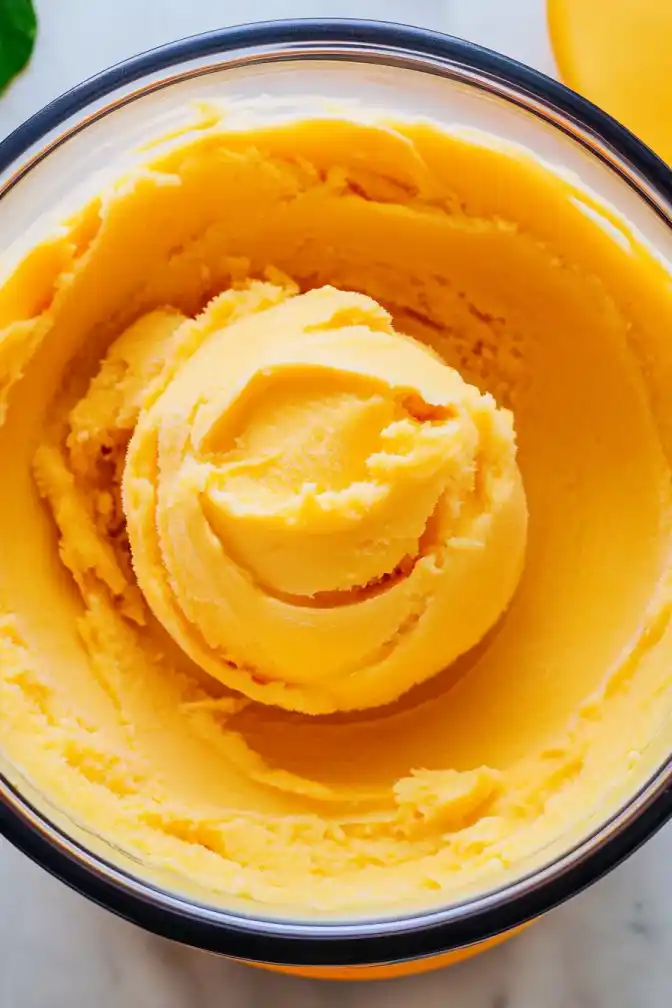The Best Fluffy Pancakes recipe you will fall in love with. Full of tips and tricks to help you make the best pancakes.

Nothing beats the sweet, tropical taste of homemade mango sorbet on a hot day. This 3-ingredient mango sorbet is smooth, naturally sweet, and incredibly refreshing. The best part? No ice cream maker required!
If you’re looking for a dairy-free, healthy frozen dessert, this easy mango sorbet is a must-try. It’s made with frozen mango, a natural sweetener, and citrus juice for the perfect balance of sweetness and tang.

Let’s dive into this simple, healthy, and delicious mango sorbet recipe! 🍨🥭
Table of Contents
Why You’ll Love This Mango Sorbet
✔️ Only 3 ingredients – No artificial flavors or preservatives.
✔️ Naturally dairy-free & vegan – A guilt-free frozen dessert.
✔️ No ice cream maker needed – Just blend, freeze, and enjoy!
✔️ Perfect for summer – Light, refreshing, and packed with mango flavor.
Looking for more refreshing desserts? Try Grape Ice Cream for another fruity treat!
🛒 Precisely Measured Ingredients
- 4 cups frozen mango chunks
- 2 tbsp maple syrup or honey (adjust for sweetness)
- 1 tbsp lime or lemon juice

✔️ Optional Add-ins:
- ½ tsp vanilla extract (for extra depth of flavor)
- Pinch of sea salt (to enhance sweetness)
- Coconut milk (for a creamier texture)
🔥 Step-by-Step Instructions: How to Make Mango Sorbet
🕒 Prep Time: 5 minutes
❄️ Freeze Time: 2 hours
🍽️ Yield: 4 servings
Step 1: Blend the Ingredients
- Add frozen mango chunks, maple syrup (or honey), and lime juice into a high-powered blender or food processor.
- Blend until smooth, stopping to scrape down the sides as needed.
- If the mixture is too thick, add 1-2 tablespoons of water or coconut milk to help blend.


✔️ Pro Tip: For an extra tropical twist, add a splash of pineapple juice!
Step 2: Freeze for a Perfect Scoopable Texture
- Transfer the blended mango mixture into a shallow freezer-safe container.
- Smooth the surface and cover with plastic wrap or a lid.
- Freeze for at least 2 hours for a firmer consistency.

✔️ For a soft-serve texture, enjoy immediately after blending!
Step 3: Serve & Enjoy!
- Let the sorbet sit at room temperature for 5 minutes before scooping.
- Scoop into bowls or cones and garnish with fresh mango slices, mint leaves, or coconut flakes.
✔️ Feeling fancy? Drizzle with passion fruit syrup for an exotic touch!
Want more easy frozen treats? Try Mango Margarita for a tropical adult twist!
Serving Ideas for Mango Sorbet
🍓 Top with fresh berries – Strawberries, blueberries, or raspberries.
🍫 Drizzle with dark chocolate – A rich and delicious contrast.
🥥 Sprinkle with coconut flakes – A tropical pairing.
🍹 Blend into a mango slushie – Add ice and blend for a quick drink.
Looking for more summer treats? Try Frozen Grapes for a refreshing snack!
10 Fun Mango Sorbet Variations
1. Mango Pineapple Sorbet 🍍
Blend 2 cups mango + 2 cups pineapple for a tropical mix.
2. Mango Raspberry Sorbet 🍇
Swirl in blended raspberries for a sweet and tangy combo.
3. Mango Coconut Sorbet 🥥
Use coconut milk instead of water for a creamier texture.
4. Mango Lemon Sorbet 🍋
Add extra lemon juice for a bright, citrusy flavor.
5. Mango Chili Sorbet 🌶️
Add a pinch of cayenne for a spicy kick!
6. Mango Banana Sorbet 🍌
Blend in 1 frozen banana for natural sweetness.
7. Mango Mint Sorbet 🍃
Mix in fresh mint leaves for a cooling twist.
8. Mango Lime Sorbet 🟢
Swap lemon for lime juice for a tangier taste.
9. Mango Peach Sorbet 🍑
Blend in ripe peaches for extra sweetness.
10. Mango Passionfruit Sorbet 💛
Drizzle with passionfruit puree for a gourmet touch.
Want more fruity recipes? Try Strawberry Purée for another vibrant option!
The Origins of Sorbet: A Refreshing Treat Through History
Did you know that sorbet has been around for centuries? It dates back to Ancient Persia, where people enjoyed frozen fruit mixtures as a way to cool off in the hot desert climate. Over time, Italian gelato makers perfected the art of sorbet, creating smooth, refreshing flavors that remain popular today.
✔️ Fun Fact: The word “sorbet” comes from the Arabic word “sharbat,” meaning a sweet, icy drink!
Want to learn more about frozen desserts? Check out Grape Ice Cream for another fruity favorite!

Choosing the Best Mangoes for Sorbet
Not all mangoes are created equal! The best mangoes for sorbet are sweet, juicy, and fiber-free.
Top Mango Varieties for Sorbet:
✔️ Ataulfo Mangoes – Small, creamy, and super sweet.
✔️ Alphonso Mangoes – Known as the “King of Mangoes,” they have a rich flavor.
✔️ Kent Mangoes – Slightly tangy and perfect for balancing sweetness.
✔️ Haden Mangoes – A classic choice with a smooth texture.
✔️ Pro Tip: If using fresh mangoes, make sure they are fully ripe before freezing for the best flavor!
For more fruit-based treats, check out Strawberry Purée!
The Science Behind Perfect Sorbet Texture
Ever wondered why some sorbets turn out icy instead of smooth? The secret lies in the sugar and freezing process.
✔️ Sugar Lowers Freezing Point: The natural sugars in mango help prevent large ice crystals from forming.
✔️ Blending Creates Smoothness: A high-speed blender ensures a creamy consistency.
✔️ Resting Before Scooping: Let sorbet sit at room temperature for 5 minutes to soften perfectly.
How to Make Mango Sorbet Without a Blender
No blender? No problem! Here’s how to make mango sorbet without a food processor:
- Mash soft mangoes with a fork or potato masher.
- Stir in honey or maple syrup and lime juice until smooth.
- Pour into a shallow container and freeze for 3-4 hours, stirring every hour for creaminess.
✔️ This method takes longer but still delivers delicious results!
Looking for more creative techniques? Check out Frozen Grapes Guide!
Can You Make Mango Sorbet With Canned Mango?
Yes! If fresh mangoes aren’t in season, you can use canned mango.
✔️ Choose Mango in Juice, Not Syrup – Avoid extra sugar.
✔️ Drain Excess Liquid – Too much moisture can make sorbet icy.
✔️ Blend & Freeze – Follow the same process as with fresh mangoes.
Want another easy frozen dessert? Try Mango Margarita!
How to Store Homemade Mango Sorbet for Freshness
Homemade sorbet doesn’t have preservatives, so proper storage is key!
✔️ Use an Airtight Container: Prevents freezer burn and ice crystals.
✔️ Place Plastic Wrap on Top: Keeps sorbet fresh and smooth.
✔️ Consume Within 2 Weeks: Homemade sorbet is best enjoyed fresh.

Mango Sorbet for Special Diets (Keto, Paleo & More!)
Mango sorbet is naturally vegan and gluten-free, but you can tweak it for specific diets.
✔️ For Keto: Use stevia or monk fruit instead of honey.
✔️ For Paleo: Stick with raw honey or coconut sugar.
✔️ For Low-Sugar: Add extra lime juice to cut sweetness naturally.
Fun Serving Ideas: How to Elevate Your Mango Sorbet
Sorbet is delicious on its own, but why not take it up a notch?
🍓 Top with Fresh Berries – Adds color and sweetness.
🥥 Sprinkle with Toasted Coconut – For a tropical vibe.
🍫 Drizzle with Dark Chocolate – A rich contrast to the fruity flavor.
🥭 Serve in a Hollowed-Out Mango – A stunning presentation for parties!
Turning Mango Sorbet into a Cocktail or Smoothie
Mango sorbet can be used for cocktails or smoothies with just a few tweaks!
Mango Sorbet Cocktail (Frozen Mango Daiquiri):
- Blend ½ cup mango sorbet with 2 oz rum and ½ cup coconut water.
- Pour into a glass and garnish with lime and mint.
Mango Sorbet Smoothie:
- Blend 1 cup mango sorbet with ½ cup almond milk and 1 banana.
- Serve immediately for a creamy, healthy drink.
For more tropical drinks, check out Frozen Mango Margarita!
Common Mistakes to Avoid When Making Sorbet
Even simple recipes can go wrong! Here’s how to avoid sorbet mishaps:
❌ Using Unripe Mangoes – Leads to a bland taste.
❌ Skipping the Sweetener – Mango alone can freeze too hard.
❌ Not Blending Properly – Leads to chunky or icy texture.
❌ Over-Freezing – Letting it sit too long without plastic wrap causes freezer burn.
FAQs About Mango Sorbet
Can I make mango sorbet without a blender?
Yes! Use a fork or potato masher to break down soft mangoes and freeze the mixture.
How long does homemade mango sorbet last?
It stays fresh in the freezer for up to 2 weeks in an airtight container.
Can I use fresh mango instead of frozen?
Yes! Just chop and freeze fresh mango before blending.
What’s the best mango for sorbet?
Ataulfo, Alphonso, or Haden mangoes are sweet and smooth.
Can I turn this into a mango cocktail?
Absolutely! Blend with rum or tequila for a frozen mango margarita.
Final Thoughts: The Ultimate Homemade Mango Sorbet
This 3-ingredient mango sorbet is the easiest, healthiest, and most refreshing dessert you can make at home. Whether you enjoy it as a light summer treat or turn it into a fruit-packed smoothie bowl, it’s a must-try recipe!
🔥 Try it today and let us know your favorite toppings!







[…] or soda. Speaking of alternatives, if you’re looking for another frozen fruit treat for kids, my Mango Sherbet is another popular choice during warmer […]